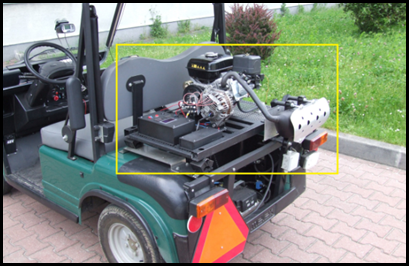Main Article Content
Abstract
Research on the effects of the use of the range extender developed for a small commercial electric vehicle was presented in this paper. The range extender has a maximum output power of 2.65 kW. The developed auxiliary power unit consists of a three-phase generator propelled by an industrial low-power spark-ignition engine. The exhaust system was improved using a more efficient muffler. The implemented motorcycle muffler has a three-way catalyst (TWC) integrated inside. The use of the more advanced exhaust system aimed at reducing noise and exhaust emissions of the range extender. The efficient operation of the three-way catalytic converter requires a stoichiometric air-fuel ratio. To enable desired air-fuel ratio a fuel system was modified. In the first stage of research, the effects of improvements of the exhaust system on the range extender noise emissions were quantified. The next step covered the research of the fuel conversion efficiency, the exhaust gas composition, and the efficiency of conversion of the three-way catalyst. A significant decrease of noise and toxic gas emissions and an increase in the fuel conversion efficiency were revealed. The mentioned research was conducted in stationary conditions. After that, in the final part research of the running vehicle with the range extender on was made. The beneficial outcome of these tests enabled the development of a set of rules of the control of the range extender.
Keywords
Article Details

This work is licensed under a Creative Commons Attribution-NonCommercial 4.0 International License.
References
- J. Paul and E. Mas, “The emergence of China and India in the global market,” Journal of East-West Business, vol. 22, no. 1, pp. 28–50, 2016.
- M. Höök and X. Tang, “Depletion of fossil fuels and anthropogenic climate change—A review,” Energy policy, vol. 52, pp. 797–809, 2013.
- C. Thiel, W. Nijs, S. Simoes, J. Schmidt, A. van Zyl, and E. Schmid, “The impact of the EU car CO2 regulation on the energy system and the role of electro-mobility to achieve transport decarbonisation,” Energy Policy, vol. 96, pp. 153–166, 2016.
- M. Dziubńiski, A. Drozd, M. Adamiec, and E. Siemionek, “Energy balance in motor vehicles,” in IOP Conference Series: Materials Science and Engineering, 2016, vol. 148, no. 1, p. 12035.
- Y. Wu and L. Zhang, “Can the development of electric vehicles reduce the emission of air pollutants and greenhouse gases in developing countries?,” Transportation Research Part D: Transport and Environment, vol. 51, pp. 129–145, 2017.
- J. Tutaj and B. Fijałkowski, “Integrated DC Electrical Machine for All-Electric and Hybrid-Electric Vehicles,”in IOP Conference Series: Materials Science and Engineering, 2018, vol. 421, no.2.
- I. Pielecha, W. Cieślik, and A. Szałek, “Energy recovery potential through regenerative braking for a hybrid electric vehicle in a urban conditions,” in IOP Conference Series: Earth and Environmental Science, 2019, vol. 214, no. 1, p. 12013.
- M. Szramowiat, “Comparison of fuel consumption between a vehicle with standard and hybrid drive system,” in IOP Conference Series: Materials Science and Engineering, 2018, vol. 421, no. 4, p. 42068.
- J. Gissing, T. Lichius, S. Baltzer, D. Hemkemeyer, and L. Eckstein, “Predictive energy management of range-extended electric vehicles considering cabin heat demand and acoustics,” IFAC-PapersOnLine, vol. 48, no. 15, pp. 209–216, 2015.
- M. Noga and P. Gorczyca, “Development of the range extender for a 48 V electric vehicle,” Combustion Engines, vol. 58, 2019.
- R. M. Dell, P. T. Moseley, and D. A. J. Rand, Towards sustainable road transport. Academic Press, 2014.
- M. Noga, “Application of the internal combustion engine as a range-extender for electric vehicles,” Combustion Engines, vol. 52, 2013.
- K. Siadkowska, M. Wendeker, A. Majczak, G. Baranski, and M. Szlachetka, “The influence of some synthetic fuels on the performance and emissions in a wankel engine,” SAE Technical Paper, 2014.
- M. Noga and Z. Juda, “The application of NiMH batteries in a light-duty electric vehicle,” Technical Transactions, vol. 12, no. 1, pp. 197–221, 2019.
- E. E. Michaelides, Energy, the environment, and sustainability. CRC Press, 2018.
- M. Adamiec, M. Dziubiński, and E. Siemionek, “Research of the alternator on the stand–efficiency aspect,” in IOP Conference Series: Materials Science and Engineering, 2018, vol. 421, p. 22001.
- B. Stojanović et al., “Length variation of toothed belt during exploitation,” Strojniški vestnik, vol. 57, no. 9, pp. 648–654, 2011.
- T. Kivevele, T. Raja, V. Pirouzfar, B. Waluyo, and M. Setiyo, “LPG-Fueled Vehicles: An Overview of Technology and Market Trend,” Automotive Experiences, vol. 3, no. 1, pp. 6–19, 2020.
- M. Wahyu, H. Rahmad, and G. J. Gotama, “Effect of Cassava Biogasoline on Fuel Consumption and CO Exhaust Emissions,” Automotive Experiences, vol. 2, no. 3, pp. 97–103, 2019.
- S. Milojević, “Sustainable application of natural gas as engine fuel in city buses: Benefit and restrictions,” Journal of Applied Engineering Science, vol. 15, no. 1, pp. 81–88, 2017.

